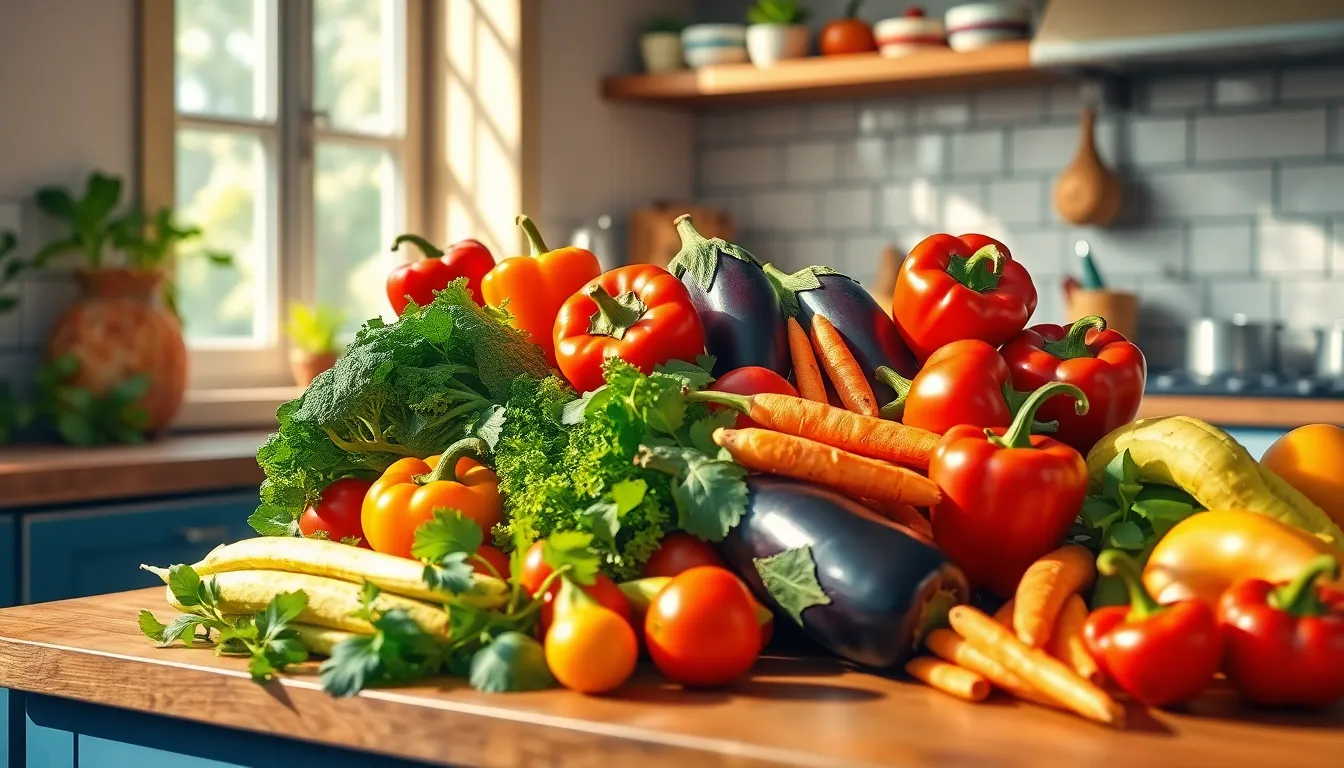Imagine walking into a kitchen bursting with vibrant colors, where each ingredient looks like it’s auditioning for a role in a culinary masterpiece. Cooking with colors isn’t just about aesthetics; it’s a delicious way to boost nutrition and elevate mood. Who knew that a sprinkle of turmeric could brighten up a dish and your day?
Table of Contents
ToggleThe Concept of Cooking With Colors
Cooking with colors emphasizes the integration of vibrant, diverse ingredients in meals. A focus on bright hues adds an appealing visual element to dishes. Colorful foods frequently signal nutritional benefits; for example, red peppers provide high levels of vitamin C, while leafy greens offer vital minerals. Many fruits and vegetables contain antioxidants that support overall health.
Engaging in color-rich cooking influences mood. Brightly colored dishes often lead to higher satisfaction during meals. Turmeric, known for its deep yellow shade, enhances not just dishes but also mental well-being. Each color in the spectrum represents different nutrients, creating a balanced plate that promotes bodily health.
Choosing a variety of colors encourages creativity in meal preparation. Incorporating a rainbow of ingredients can transform a simple dish into an enticing culinary experience. Purple eggplants, orange carrots, and green broccoli come together to create vibrant salads or stir-fries. These selections not only stimulate the palate but also enhance the overall nutrition profile of the meal.
Prioritizing colorful ingredients fosters dietary diversity. Meals rich in color often contain higher amounts of fiber, vitamins, and minerals essential for health. By highlighting these ingredients, cooks cultivate both an aesthetic and nourishing dining experience. Embracing the concept of cooking with colors leads to benefits far beyond mere appearance; it enriches both meals and lives.
Benefits of Cooking With Colors
Cooking with colors offers numerous benefits, enhancing both nutrition and psychology. Emphasizing diverse ingredients leads to a more balanced diet and improved mood.
Nutritional Advantages
Colorful foods provide essential vitamins and minerals. Red peppers supply vitamin C, while leafy greens deliver iron and calcium. Each color corresponds to specific nutrients, contributing to overall health. For example, orange fruits, like carrots, contain beta-carotene that supports eye health. Incorporating a variety of hues promotes dietary diversity, making meals richer in fiber and antioxidants. Antioxidants help combat free radicals, enhancing the immune system. Eating a rainbow of fruits and vegetables ensures a well-rounded intake of beneficial compounds.
Psychological Effects
The visual appeal of colorful meals impacts mood positively. Brightly colored dishes can increase appetite and encourage mindful eating. Research indicates that engaging with vibrant foods elevates overall satisfaction during meals. Colors like yellow and orange tend to evoke feelings of happiness, while greens promote tranquility. Cooking experiences filled with colors can inspire creativity in the kitchen. Vibrant presentations may also foster social interactions, making gatherings more enjoyable. Eating a colorful plate not only nourishes the body but also uplifts the spirit.
Techniques for Cooking With Colors
Cooking with colorful ingredients enhances both aesthetics and nutrition. Incorporating a variety of hues elevates the meal’s appeal and boosts health benefits.
Selecting Colorful Ingredients
Choosing vibrant fruits and vegetables ensures optimal nutrient intake. Reds, like strawberries and tomatoes, provide antioxidants and vitamins. Oranges, including carrots and sweet potatoes, contribute beta-carotene and fiber. Dark leafy greens, such as spinach and kale, offer iron and calcium. Purple foods like eggplant and beets contain powerful phytonutrients. Selecting a rainbow of ingredients leads to a well-rounded diet, supporting overall wellness and vitality.
Creative Cooking Methods
Utilizing various cooking methods showcases colors effectively. Roasting vegetables intensifies their natural hues and flavors. Steaming preserves vibrant colors and nutrients. Sautéing adds a quick and colorful touch to stir-fries. Grilling enhances both color and taste, offering a smoky char. Incorporating raw options like salads brings freshness and visual appeal. Experimenting with cooking methods encourages creativity while enhancing the dish’s aesthetic and nutritional value.
Color Combinations and Their Effects
Cooking with colors not only refreshes meals but also impacts health and well-being. Each color group offers unique benefits, enhancing both the visual and nutritional aspects of cooking.
Warm Colors
Warm colors comprise red, orange, and yellow. Red foods like tomatoes and red peppers boost appetite and energy levels. Carrots and sweet potatoes, rich in beta-carotene, support eye health and immunity. Yellow foods such as bananas and pineapples provide potassium, promoting heart health. Combinations of warm colors evoke feelings of warmth and excitement, making dishes more inviting. Meals featuring these colors often uplift moods, enhancing the overall dining experience.
Cool Colors
Cool colors include green, blue, and purple. Green leafy vegetables like spinach and kale contain iron and calcium, contributing to strong bones and overall vitality. Blue and purple foods such as blueberries and eggplant offer antioxidants that protect against cellular damage. The calming nature of cool colors creates a sense of tranquility during meals, which can lead to more mindful eating practices. Incorporating diverse cool-colored ingredients enriches meals with essential nutrients, providing both satisfaction and health benefits.
Conclusion
Embracing the art of cooking with colors transforms meals into vibrant culinary experiences. By integrating a variety of colorful ingredients, individuals not only enhance the visual appeal of their dishes but also unlock a wealth of nutritional benefits. Each hue brings unique nutrients that contribute to overall health and well-being.
The positive impact of colorful foods extends beyond nutrition, influencing mood and satisfaction during meals. As creativity flourishes in the kitchen, the joy of preparing and enjoying meals increases. By making a conscious effort to incorporate a rainbow of colors, one can elevate both the dining experience and their health. Cooking with colors isn’t just about aesthetics; it’s about nourishing the body and spirit.









